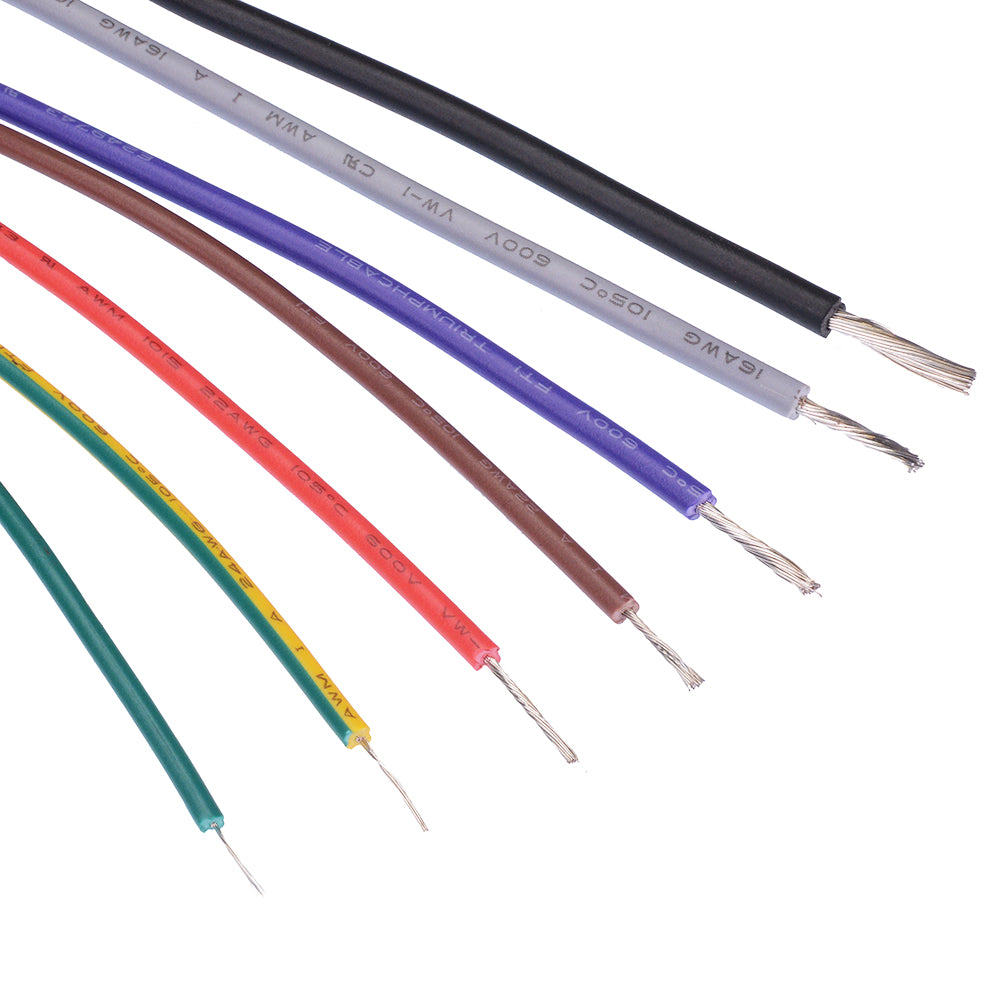
Electronics & Automotive Cable Guide
Overview
Cables are used in almost every electrical circuit; they transfer electricity between components and devices. Choosing the correct size cable for your circuit is critically important and can also seem quite daunting. With 1000s of different types and sizes suited for specific applications, choosing the wrong cable can create excess heat which may cause a fire risk.
Types of cables
Cables are constructed from a conductor and insulator. The conductor transfers electricity along the cable and the insulator is a non-conductive material which surrounds and protects the conductor. There are various combinations and types of insulators and conductors suited for specific applications which we will explain below.
The most common conductor is copper, it provides excellent conductivity and is more cost effective than other conductive elements such as silver or gold. The conductor is often available as a stranded or solid core. Solid core has a higher current capability but is more brittle, it is commonly found in household wiring where the cable is not going to be moved. Stranded core has a larger surface area due to the individual strands which helps dissipate heat and makes the cable more flexible. This makes it suited for applications including automotive.

The insulation comes in various materials each with their own properties. The most common insulation is PVC due to its low cost and durable properties. Silicone is another popular insulator; it provides higher heat resistance than PVC and is also very flexibly making it popular for applications with a small amount of space and high temperatures. Silicone insulations is also lighter than PVC making it common for use with drones and RC vehicles, the main downside is the higher cost.
Cable comes in a wide number of cores with an outer protective sheath often manufactured by PVC. Most equipment cable is single or 2-cores, however applications including automotive, and marine require up to 13 cores. Using multi-core cable helps keep your wiring tidy, provides extra protection and conserves space.
Cable specifications
There are various terminologies used with cable, so it is important to understand this. Here are the most common to help you choose the correct cable
How to choose the correct cable
- Tinned or bare copper?
Most cables use a bare copper conductor which although provides excellent conductivity, they are prone to oxidise over time in environments with moisture. The oxidisation can cause higher resistance and cause poor electrical contacts. The solution to this is a tinned copper conductor, each strand is coated in a small amount of tin which helps prevent oxidation. For harsh environments like marine and some outdoor applications, it is advisable to use a tinned copper conductor.
- Insulation material
For most applications PVC insulation will be suitable and will provide a cost saving over other insulation materials. However, you may require an insulation with higher temperature rating, more flexibility or resistance to chemicals. Silicone insulation is a good choice for high temperature environments and often has a temperature rating up to 200°C. Rubber and PTFE insulation provides excellent resistance to chemicals including oil and Petrol. It is advised to consider the environment and properties necessary for the cable, then you can make an informed decision on the insulation.
- Current rating
Once you have selected the cable material, the next step is calculating the current rating required. If you don’t know the current rating of your circuit, you can calculate it using wattage/voltage which equals the current. For example, 100W/12V = 8.33A. It is never advised in electronics to run components to their maximum capacity, so if you require a 5A cable it is best practice to choose the next size up.
Tip: There is no harm using a higher current rated cable than is necessary, it is best to be safe than risk it being underrated!
- Voltage drop
All electrical cables have resistance which causes a voltage drop. With some components like bulbs, the voltage drop is wanted and causes the bulbs to illuminate. However, with cable this is not wanted because its job is to transfer all the current with minimal loss.
For some cables the voltage drop can be minimal, however for low voltage circuits with a long cable length, the voltage drop can be significant. We can minimise the voltage drop by using a larger cross sectional area cable with a lower resistance.
Voltage drop = current draw x (cable length x resistance per meter)
Example: if we have a 20W light with a 12V circuit and 5 meters of cable with a resistance of 0.02Ω/M, we can work out the voltage drop below.
Voltage drop = 1.66A x (5M x 0.02Ω/M) = 0.166V
This voltage drop would be acceptable for use with a 20W light, however if the voltage drop exceeds 3% of the voltage it is advised to use a larger size cable which will typically have a lower resistance.
Cable applications
Here are a few of the most common applications we come across and their recommended cables.
Automotive
For most automotive applications we usually recommend thin wall PVC insulated cable. This cable has a thinner insulation than regular PVC, meaning it is lighter and has a higher operating temperature range. This makes it suitable for wiring close to the engine and it uses a higher-grade PVC which is more resistance to abrasion and cutting.
Marine
For marine applications we recommend using a tinned copper cable. Due to the high moisture environment regular copper cable will oxidise over time and cause performance issues. Tinned copper will provide a much longer life span and increased reliability.
RC vehicles and drones
For these applications the cable needs to be lightweight and flexible. Silicone cable is the preferred choice due to its extreme flexibility which can be used in tight spaces, the silicone insulation is also significantly lighter than PVC which makes it the preferred choice.
Prototyping
For prototyping and general PCB work, regular PVC insulated copper cable is the most popular and preferred choice. This application often does not work in high temperatures and is in a controlled environment. The low cost of PVC insulated cable makes it the preferred choice unless the application has more specific requirements.
AWG to metric
Cable is often measured in metric or AWG (American wire gauge). Generally speaking, Europe measures cable in metric and American uses the AWG measurement. However, other parts of the world also use either of these measurements. Cable is manufactured all over the world, so it is common to come across both measurements even if you live in Europe or North America.
AWG to Cross-Sectional Area Converter
We have included this handy table below to help you convert between the two.
|
AWG |
Cross Sectional Area mm2 |
Nearest Size mm2 |
|
00 (2/0) |
67.4 |
70.0 |
|
0 (1/0) |
53.46 |
50.0 |
|
1 |
42.39 |
40.0 |
|
2 |
33.61 |
35.0 |
|
4 |
21.14 |
20.0 |
|
6 |
13.29 |
16.0 |
|
8 |
8.36 |
8.5 |
|
10 |
5.26 |
6.0 |
|
12 |
3.31 |
3.0 |
|
14 |
2.08 |
2.0 |
|
16 |
1.31 |
1.5 |
|
18 |
0.82 |
1.0 |
|
20 |
0.52 |
0.5 |
|
22 |
0.33 |
0.35 |
|
24 |
0.20 |
0.25 |
|
26 |
0.13 |
0.15 |
|
28 |
0.08 |
0.1 |
|
30 |
0.05 |
0.05 |





Leave a comment